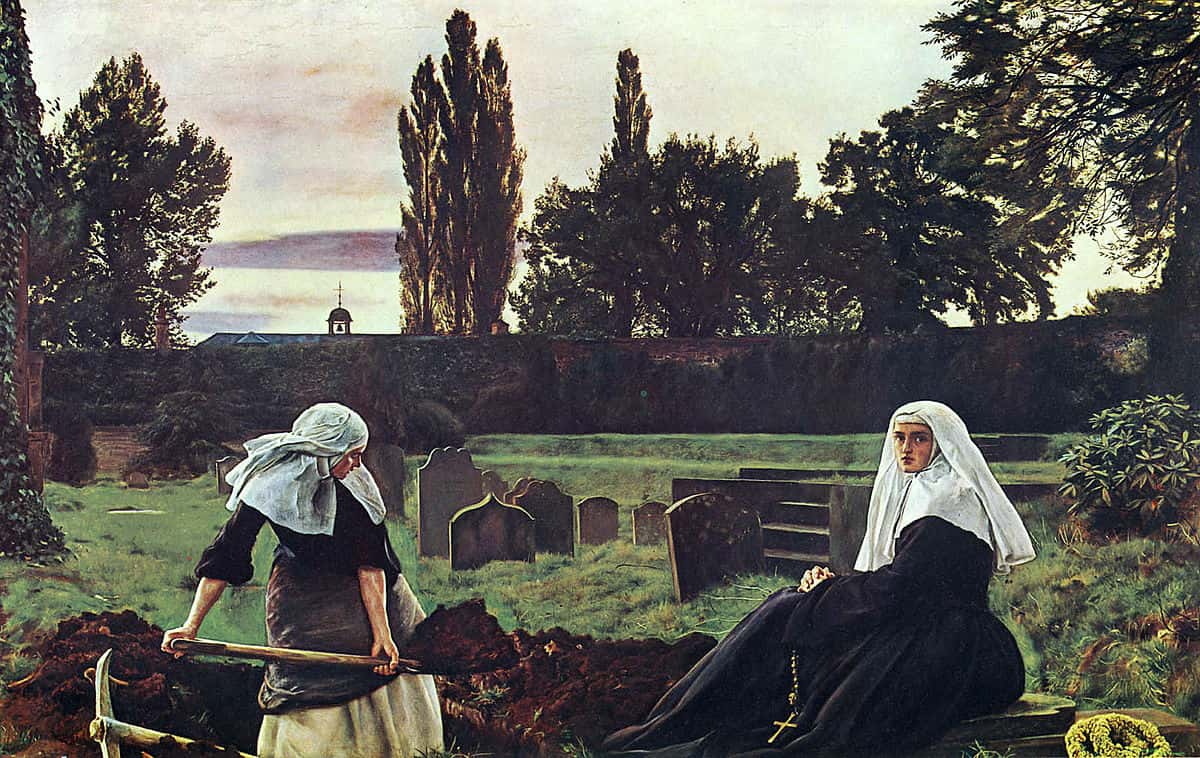“[People] ate lunch with their friends and had dinner with their ancestors in paradise.”
So said the poet Boccaccio about the effects of The Black Death during the Middle Ages. It was his interpretation of the awful killing power which had been unleashed on the Medieval world. Seemingly healthy, hardy people were almost instantly overcome with the awful, ugly sickness. Once infected, Death was swift, painful, and almost unavoidable...
With absolutely no knowledge of what was causing it, or how to treat it, millions of people would eventually be killed by what we know today to be the bubonic plague. As a result of the sheer scale of devastation (in both Europe and the rest of the world) the Black Plague was one of the most important and influential events in world history. In response to the hellish reality around them, some of those who survived became increasingly fanatical in their devotion to the church... while others gave up on God entirely. And while rates of death and infection varied from country to country, place to place, one thing was constant all around: after the Black Plague hit, life was never the same again...
Here are 40 facts about the terrifying pestilence that once completely decimated the human population.
40. Three Years of Hell
It's hard to say the exact beginning and end of the epidemic, but the Black Death was affecting the world between 1346 and 1353, with the most severe epidemic lasting between 1349 and 1351.
The end of the major outbreak was hardly the end for the Black Death, though. For the next few centuries, particularly in Europe, outbreaks of the bubonic plague were relatively common. By the estimates of some historians, a large spreading of the disease happened on the continent about once every ten years, up until the 19th century.
39. Death Comes Sailing In…
We can actually track the precise moment that the plague arrived in Europe:
In October 1347, 12 Genoese trading ships docked in the Italian port of Messina after crossing the Black Sea. People greeting these ships found the crews dead or dying, covered in boils and with high fevers. The ships were immediately ordered to leave the harbor, but it was too late. The Black Death had arrived.
38. What’s in a Name?
The Black Death got its name from the black, pus and blood-filled boils that covered its victims’ bodies.
To contemporaries, it was also known as “The Pestilence” or “The Great Mortality.”
37. If Only They'd Known
For centuries, the cause of the The Black Death was unknown, making it all the more terrifying. Insane theories spread like wildfire... almost as quickly as the disease itself. And that's hardly shocking: can you imagine what you would think was happening? Almost everyone you know is suddenly dying in horrific agony... and you've got absolutely no reason why. You don't even have a basic understanding of what germs are, or how a common cold would spread.
Suffice to say, to those alive at the time the Black Death was an absolute mystery.
Today, though, we know that it was actually an outbreak of the bubonic plague. It was caused by a bacterium known as Yersinia pestis which traveled via fleas carried by infected rodents and rats.
36. The Body Count
Estimates regarding the number of people actually killed by the Black Death vary, but historians generally agree that it claimed somewhere between 75 and 200 million people in its first five years. Experts suggest the number of those killed represented 30% to 60% of the entire population of Europe.
That amount of devastation is genuinely difficult to properly understand. Entire towns were hit so hard they had to be left abandoned. They stayed unoccupied for years, for fear of recontamination. Across Europe, these previously lively settlements lay unguarded and unpopulated... ghostly reminders of the plague's ferocious power.
In the end, it would take 150 years for the continent to recover its population.
35. Global Epidemic
The Black Plague is usually associated with Europe, but it also killed around half of the population of China and one-eighth of the people in Africa.
It was a truly worldwide phenomenon, similar in scale to the World Wars in terms of the number of people affected.
34. Wiped Out
Without treatment, the Bubonic plague kills 30-90% of the people who come in contact with it.
Today, it can be treated rather simply with antibiotics, but the people of the Middle Ages had no such option. They were forced to simply wait and pray, in the faint hope that the deathly pathogen left them alive...
33. Island of Death
People suffering from the Black Death in Italy were sent to the island of Poveglia in an attempt to stop the disease from spreading. As such, countless Italians died there. It's rumored that, to this day, 50% of the island's soil consists of human ash.

32. Back Where it All Began
The Black Death is over 2,000 years old and originated in China. Through gene sequencing, scientists have determined that it spread to the rest of the world through fleas that lived on the rats that stowed away in trading vessels.
31. Symptoms
In addition to the boils, the plague caused fever, chills, vomiting and uncontrollable diarrhea. Those afflicted also suffered through debilitating aches and pains and death would usually occur within two to seven days of infection.
30. Halted Construction
Since more than half of the population of the Italian city of Sienna succumbed to the plague, construction on its cathedral—one of the largest at the time—was halted. Building never resumed and you can still view the outer walls of the unfinished cathedral in the town.
It's hard to commit to a project that will outlive you when death seems to be around every corner.
29. Weapon of Mass Destruction
In 1345-46, just before the plague arrived in Europe, Mongol hordes were struck by the plague as they laid siege to the town of Kaffa. As their numbers quickly diminished, the Mongols began to hurl the bodies of those who had died from the plague into the walled city, in an attempt to turn the bodies into plague-carrying agents of mass destruction.
 Tagmata Not cool, Mongols.
Tagmata Not cool, Mongols.
28. Sole Survivor
The brother of the famous poet Petrarch, named Gherardo, was one of only two to survive when the plague reached his Carthusian monastery in Italy. He was forced to bury 34 of his fellow monks who weren't so lucky. The other survivor? Gherardo's dog.
 Torso - Torso La revue de Cinéma de Genre
Torso - Torso La revue de Cinéma de Genre
27. Bring Out Your Dead
Many people were so terrified of the Black Death that they refused to help those who were sick. Doctors refused to attend to patients, priests refused to give last rites and even relatives would sometimes abandon their sick family members.
26. All the Animals Too
Humans weren’t the only creatures to suffer during the plague. It also affected cows, pigs and sheep. In fact, so many sheep were affected that is caused a shortage of wool in Europe.
25. The Blame Game
At the time, people didn’t blame the fleas. Many believed that the plague was God’s punishment for people's immorality. There were others who credited the alignment of the planets. Sadly, many others blamed the Jews.
24. Scapegoats
Local religious leaders suggested that Jews had poisoned village wells, and this was causing the plague. As a result, numerous atrocities including forced conversions, exiles, torture, and mass executions took place. In Basel Switzerland, the entire Jewish population was herded into a building and burned to death in 1349.
23. The Church
The population wasn’t the only thing to decline during the Black Death. The Catholic Church also lost a lot of its power and influence as it failed to protect people from the plague. This destabilization is seen as a major factor in the Protestant Reformation that would soon follow.
 The Center for the Humanities It's really difficult to convince people that the death of half their friends and family is "all part of God's plan".
The Center for the Humanities It's really difficult to convince people that the death of half their friends and family is "all part of God's plan".
22. A Chicken a Day
Another popular treatment for the Black Death had people pressing the shaved bottom of a live chicken against the boils of an infected person. The only problem was that the chickens then also became infected and helped spread the disease.
Also (and this is going to surprise you), it didn't work. Turns out shaved chicken bums are exactly 0% more medically useful than regular old people-bums.
 The Spruce Don't tell this guy, though.
The Spruce Don't tell this guy, though.
21. The Speedy Plague
The spread of the Black Plague was almost inconceivably rapid. According to some estimates, the disease traveled between populations (through being carried by hosts) at an average speed of 8 miles a day.
Compare that to 20th century plagues which have been found to travel at a rate of eight miles per year or slower.

20. The First Quarantine
The idea of quarantining to prevent a highly contagious disease was not understood in medieval times. In fact, the word didn’t even exist yet. However, the Mediterranean city of Ragusa did manage to establish a "trentino," which was designed to isolate infected people outside the city and to refuse entry to foreigners. The move effectively ended the plague in the city much earlier than throughout the rest of Europe.
This might seem to be an obvious solution to spreading illness, and it's easy to ask why the thought of isolating a population from infected people didn't occur to people earlier. But it's worth remembering: the concept of quarantine only makes sense to us because we know that germs and bacteria spread disease. If a population hasn't discovered germ theory, it's difficult (if not impossible) to understand that contact with an infected host is what leads to contracting the illness. You're just as likely to think that infection is a case of bad luck.
When it comes to the Black Plague, for example, the leading theories for what was happening centered around the movement of planets, or the wrath of an angry God... or even just "bad air". All of which, if you believed them to be the cause of the Black Death, wouldn't exactly be solved by cutting yourself off from other people.
19. Penance and Punishment
In keeping with the idea that the Black Death was God’s punishment for people’s sins, some men joined groups called flagellants. They traveled from town to town beating themselves and each other with leather straps studded with metal three times a day, in the hope that their penance would spare them from God's wrath.
18. An Indiscriminate Killer
The Black Death made no distinction between rich and poor in its early days. In fact, many wealthy convents and monasteries lost more than half of their people, some even becoming completely extinct. However, by the end of the 14th century, outbreaks of the plague were largely confined to the poor due to their lack of access to anything approaching sanitary conditions.
17. Stinky Cures
In addition to covering themselves feces and urine (which they were encouraged to drink as well), medieval people also avoided the plague by avoiding the bathtub. It was commonly believed that bathing opened up the pores and would allow the plague easy entry into the body. Maybe the stench would also help keep it away? Worth a shot, I suppose.
 Brownstoner Pictured: A medieval peasant's worst nightmare.
Brownstoner Pictured: A medieval peasant's worst nightmare.
16. Was Trade the Cause?
Trade routes that were established in the Middle Ages brought riches and new goods to Europe, Asia and Africa but it also provided a pathway for the Black Death to travel between these three continents.
15. Cursed Ship
The Black Death likely traveled to Norway via a ship that ran aground near Bergen harbor. Some rumors have flown saying that all the sailors were already dead from the horrifying disease, but a historical account relays a more gruesome truth: that when one plague-ridden ship arrived, the crew was still alive. They died soon after unloading a bit of the ship, and the disease began to spread through the town.
14. Starving Fleas
Y. Pestis, the type of bacteria that caused the Black Death, blocks the stomachs of the fleas it infects. The fleas attempt to feed voraciously but are unable to keep anything down and so they vomit their food back onto their host. Once the host dies, they jump to the next host and begin again.
13. A Dog’s Life
While rats, cats and numerous other types of animals could contract the Black Death, dogs rarely did. This is because they have a natural resistance to the plague and could be exposed to the disease without being infected.
12. Not the First
The Black Plague was probably the worst pandemic the world has suffered but it wasn’t the first—there have many plagues noted earlier in history. The first was in Athens in Ancient Greece, which decimated the city's population. Justinian’s plague, which struck Europe during the 6th century, occurred hundreds of years before the Black Death and killed upwards of 50 million people.
 Pinterest
Pinterest
11. The Arts Thrived
The Black Death ravaged the art world just like every other population, but following the plague arts and culture thrived. Wealthy nobles commissioned paintings and sculptures depicting the death, destruction and suffering that had occurred. The subject of artistic work also changed drastically and became much darker and more bleak.
10. Peasant Power
One positive effect of the Black Death was a rise in wages and an improvement in working conditions since landowners were forced to compete for a much smaller workforce. Peasants no longer had to stay with a master as they could immediately find work elsewhere if they chose to leave.
9. It’s Still Here
The world hasn’t seen anything quite like the Black Death, but the bubonic plague was never truly wiped out and there are still occasional outbreaks. The most recent, in Madagascar in October 2017, killed 124 people and infected 1200 others.
8. Places to Be (and Not to Be)
The Black Death did not hit every country equally, especially in Europe. It killed 70-80% of the population in southern Europe (Spain, France and Italy) but only 20% of the population of more northern countries like England and Germany.
7. The Other Killer
The Black Death caused shortages and price increases in staples such as wheat. In fact, the price of wheat in Italy rose 200% in Italy in the winter of 1347. At least 4000 people died of malnutrition in the city of Florentine that year. By 1350 it had increased 400% in France.
6. London Plague
In 1348, the Black Death hit the city of London particularly hard, with the city’s crowded conditions making it difficult to escape infection. On average they were burying 34 people every single day.
5. Who Invaded Who?
In 1349, taking advantage of an England already weakened by the plague, the Scots invaded the city of Dunham in England. Unsurprisingly, once they got there they too caught the plague. 5,000 Scottish soldiers died, and the survivors brought the plague back with them to Scotland, killing thousands more.
4. Goodbye Feudalism
Though it caused immense suffering and death, the Black Plague ended up having one huge positive impact that not many people know about.
The shortage in labour lead to higher wages and peasants were free to leave for towns and higher paying jobs. With their cheap labour source gone and with land becoming far less valuable, nobles lost their tight control of the social strata and feudalism began to quickly disappear.
3. Cure You or Kill You
Some of the cures that were used by physicians actually made things worse: Physicians would burst plague boils, which only helped spread infection. Another treatment involved applying human excrement to the boils, which probably caused entirely new diseases in the victim, on top of the fact that they, you know, applied human excrement to plague boils.
2. Mass burials
As villages became overwhelmed by the sheer number of dead, religious leaders struggled with how to bury people according to Christian traditions. Mass graves were dug and Pope Clement VI consecrated the entire Rhone River so corpses could be thrown into it and still be assured a place in heaven.
1. Strength in Numbers
Yersinia pestis, the bacteria responsible for the Black Plague, is unable to survive outside the body of its victims and is unable to penetrate or hide on a body. But it has a secret weapon: it can disable its host's immune system. With nothing to oppose it, it can multiply quickly and overrun a victim within hours.

Sources: 1, 2, 3, 4, 5, 6, 7, 8, 9, 10, 11, 12, 13, 15, 16, 17, 18, 19, 20, 21, 22, 23, 24, 25, 26, 27, 28, 29, 30, 31, 32, 33, 34, 35, 36, 37, 38, 39, 40, 41








































